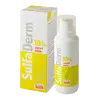What's inside
What's inside
 Key Ingredients
Key Ingredients

 Benefits
Benefits

 Concerns
Concerns

 Ingredients Side-by-side
Ingredients Side-by-side

Water
Skin ConditioningGlycerin
HumectantSulfur
AntiseborrhoeicCaprylic/Capric Triglyceride
MaskingCetearyl Ethylhexanoate
EmollientButyrospermum Parkii Butter
Skin ConditioningGlyceryl Stearate Citrate
EmollientGlyceryl Stearate
EmollientDimethicone
EmollientDimethicone/Vinyl Dimethicone Crosspolymer
Skin ConditioningTocopherol
AntioxidantCetearyl Alcohol
EmollientXanthan Gum
EmulsifyingLactic Acid
BufferingParfum
MaskingSodium Benzoate
MaskingPotassium Sorbate
PreservativeWater, Glycerin, Sulfur, Caprylic/Capric Triglyceride, Cetearyl Ethylhexanoate, Butyrospermum Parkii Butter, Glyceryl Stearate Citrate, Glyceryl Stearate, Dimethicone, Dimethicone/Vinyl Dimethicone Crosspolymer, Tocopherol, Cetearyl Alcohol, Xanthan Gum, Lactic Acid, Parfum, Sodium Benzoate, Potassium Sorbate
Water
Skin ConditioningCaprylic/Capric Triglyceride
MaskingDimethicone
EmollientDicaprylyl Ether
EmollientCetearyl Alcohol
EmollientLactamide Mea
HumectantGlycolic Acid
BufferingGuanidine Carbonate
BufferingGlyceryl Stearate
EmollientPolymethyl Methacrylate
Ceteareth-33
CleansingBisabolol
MaskingEthanolamine
BufferingGlycyrrhetinic Acid
Skin ConditioningPiroctone Olamine
PreservativeSerenoa Serrulata Fruit Extract
Skin ConditioningSodium Chloride
MaskingTetrasodium EDTA
Tocopherol
AntioxidantWater, Caprylic/Capric Triglyceride, Dimethicone, Dicaprylyl Ether, Cetearyl Alcohol, Lactamide Mea, Glycolic Acid, Guanidine Carbonate, Glyceryl Stearate, Polymethyl Methacrylate, Ceteareth-33, Bisabolol, Ethanolamine, Glycyrrhetinic Acid, Piroctone Olamine, Serenoa Serrulata Fruit Extract, Sodium Chloride, Tetrasodium EDTA, Tocopherol
Ingredients Explained
These ingredients are found in both products.
Ingredients higher up in an ingredient list are typically present in a larger amount.
This ingredient is an emollient, solvent, and texture enhancer. It is considered a skin-softener by helping the skin prevent moisture loss.
It helps thicken a product's formula and makes it easier to spread by dissolving clumping compounds.
Caprylic Triglyceride is made by combining glycerin with coconut oil, forming a clear liquid.
While there is an assumption Caprylic Triglyceride can clog pores due to it being derived from coconut oil, there is no research supporting this.
Learn more about Caprylic/Capric TriglycerideCetearyl alcohol is a mixture of two fatty alcohols: cetyl alcohol and stearyl alcohol. It is mainly used as an emulsifier. Emulsifiers help prevent the separation of oils and products. Due to its composition, it can also be used to thicken a product or help create foam.
Cetearyl alcohol is an emollient. Emollients help soothe and hydrate the skin by trapping moisture.
Studies show Cetearyl alcohol is non-toxic and non-irritating. The FDA allows products labeled "alcohol-free" to have fatty alcohols.
This ingredient is usually derived from plant oils such as palm, vegetable, or coconut oils. There is debate on whether this ingredient will cause acne.
Due to the fatty acid base, this ingredient may not be Malassezia folliculitis safe.
Learn more about Cetearyl AlcoholDimethicone is a type of synthetic silicone created from natural materials such as quartz.
What it does:
Dimethicone comes in different viscosities:
Depending on the viscosity, dimethicone has different properties.
Ingredients lists don't always show which type is used, so we recommend reaching out to the brand if you have questions about the viscosity.
This ingredient is unlikely to cause irritation because it does not get absorbed into skin. However, people with silicone allergies should be careful about using this ingredient.
Note: Dimethicone may contribute to pilling. This is because it is not oil or water soluble, so pilling may occur when layered with products. When mixed with heavy oils in a formula, the outcome is also quite greasy.
Learn more about DimethiconeGlyceryl Stearate is a mix of glycerin and stearic acid.
It is used to stabilize the mixing of water and oil ingredients. By preventing these ingredients from separating, it can help elongate shelf life. It can also help thicken the product's texture.
As an emollient, it helps soften skin and supports barrier-replenishing ingredients.
In cosmetics, Glyceryl Stearate is often made from vegetable oils or synthetically produced.
This ingredient may not be fungal-acne safe
Fun fact: The human body also creates Glyceryl Stearate naturally.
Learn more about Glyceryl StearateTocopherol (also known as Vitamin E) is a common antioxidant used to help protect the skin from free-radicals and strengthen the skin barrier. It's also fat soluble - this means our skin is great at absorbing it.
Vitamin E also helps keep your natural skin lipids healthy. Your lipid skin barrier naturally consists of lipids, ceramides, and fatty acids. Vitamin E offers extra protection for your skin’s lipid barrier, keeping your skin healthy and nourished.
Another benefit is a bit of UV protection. Vitamin E helps reduce the damage caused by UVB rays. (It should not replace your sunscreen). Combining it with Vitamin C can decrease sunburned cells and hyperpigmentation after UV exposure.
You might have noticed Vitamin E + C often paired together. This is because it is great at stabilizing Vitamin C. Using the two together helps increase the effectiveness of both ingredients.
There are often claims that Vitamin E can reduce/prevent scarring, but these claims haven't been confirmed by scientific research.
Learn more about TocopherolWater. It's the most common cosmetic ingredient of all. You'll usually see it at the top of ingredient lists, meaning that it makes up the largest part of the product.
So why is it so popular? Water most often acts as a solvent - this means that it helps dissolve other ingredients into the formulation.
You'll also recognize water as that liquid we all need to stay alive. If you see this, drink a glass of water. Stay hydrated!
Learn more about Water